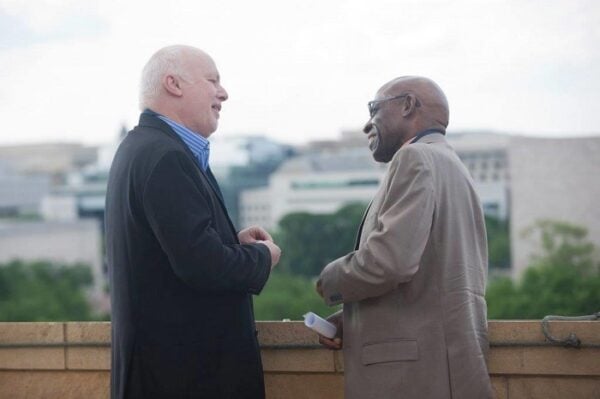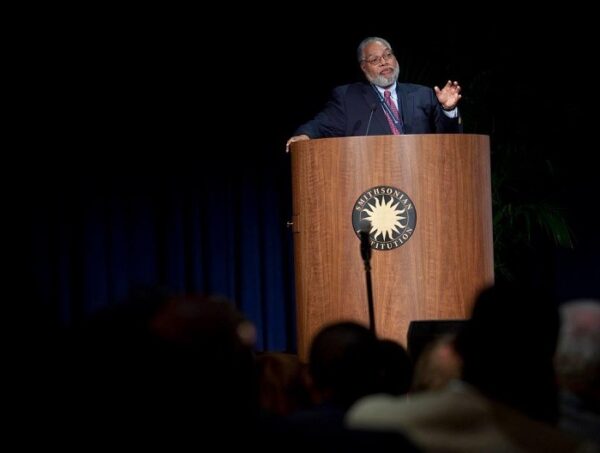The Future of the African American Past, a conference held May 19–21 in Washington, DC, brought together public audiences and scholars from several generations to assess the changing field of African American history and to celebrate the September 2016 opening of the Smithsonian National Museum of African American History and Culture (NMAAHC), the first national museum devoted specifically to African American history, and the last to be built on the National Mall. Here are a series of photographs from the conference and celebration.

Conference participants and guests gathered for a reception at the National Museum of the American Indian (NMAI). Some, such as Shane White (left, Univ. of Sydney), had traveled great distances from their home institutions; others, like Joe William Trotter Jr. (Carnegie Mellon Univ.), came from proximate locations. Participants described the event as a “homecoming” for friends and colleagues who had not seen one another for years.

Barbara Ransby (not pictured, Univ. of Illinois at Chicago) chaired the opening roundtable, “The Long Struggle for Civil Rights and Black Freedom,” which included activists from the last half century. Rosalyn Terborg-Penn (left, Morgan State Univ.) spoke about joining “the movement” in the early 1960s in New York City. Jessica Pierce (right, Black Youth Project 100), lent the perspective of a new generation of activists.

NMAAHC founding director Lonnie Bunch welcomed the audience and reminisced about the evolution of the conference—from early conversations with AHA executive director James Grossman into a landmark event cosponsored by the AHA and backed by the National Endowment for the Humanities, with support from History. Bunch argued that the new museum would “recenter the African American experience.”

Friday’s events kicked off with the question “Who is Black America?” This session, led by Ira Berlin (left, Univ. of Maryland), examined changes to the meaning of “black” culture throughout history. Other Friday sessions addressed slavery and freedom, race in urban spaces, and the historical impact of African American labor. A video archive of all sessions is available on the Future of the African American Past website (futureafampast.si.edu).

Over three days, more than 1,100 people attended the conference. Guests received programs, posters, and tote bags printed with specially designed Future of the African American Past imagery. Each session was allotted a question-and-answer period, and audience members such as Junius Williams (Rutgers Univ.) played a critical role in the trajectory of debates. Attendees were encouraged to read papers by the panelists in advance.

The final session, “African American History as American History,” featured Nell I. Painter (Princeton Univ.), Thomas C. Holt (Univ. of Chicago), Earl Lewis (Andrew W. Mellon Foundation), Darlene C. Hine (Northwestern Univ.), James Grossman, and Jacqueline Jones (Univ. of Texas at Austin), pictured from left. Panelists spoke about generational perspectives, historians’ roles in shaping public perception of the field, and the future of the academic job market.

“How do we make history relevant to our students?” asked Tasneem Siddiqui (Winston-Salem State Univ.) during a session. One of the conference’s central aims was to bring the voices of new generations into the conversation about the African American past. Younger audience members were often the most eager to ask questions and challenge the panelists. Several history departments provided travel support for their students.

The conference included several scholars participating as bloggers. Tasked with reflecting on a designated session, they were encouraged to bring a personal voice to their writing and to help fill lacunae. Adam Green (Univ. of Chicago) composed a piece titled “African American History: Of Dreams and Struggles,” which covered the entire range of sessions. All blog posts, including Green’s, can be found at futureafampast.si.edu/blog.
Photos by Leah L. Jones
This work is licensed under a Creative Commons Attribution-NonCommercial-NoDerivatives 4.0 International License. Attribution must provide author name, article title, Perspectives on History, date of publication, and a link to this page. This license applies only to the article, not to text or images used here by permission.



